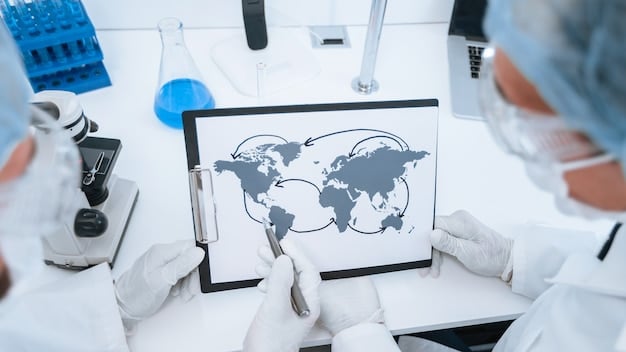The Future of Biodefense: Navigating the Next Pandemic Threat

The future of biodefense hinges on proactive strategies, technological advancements, and international cooperation to effectively prepare for and mitigate the impact of emerging pandemic threats, ensuring global health security.
As the world reflects on the lessons learned from recent global health crises, the spotlight intensifies on the future of biodefense: preparing for the next pandemic threat. This critical field is evolving rapidly, driven by innovations, strategic planning, and the urgent need to safeguard national and global populations from emerging biological threats.
Understanding the Evolving Landscape of Biodefense
Biodefense has transcended traditional notions of national security to encompass a broader understanding of global health security. This evolution recognizes that biological threats can emerge anywhere and spread rapidly, necessitating a coordinated, international approach.
The Expanding Definition of Biodefense
Traditionally, biodefense focused primarily on protecting against biological weapons. However, the scope has broadened significantly to include naturally occurring infectious diseases, accidental releases of pathogens, and even deliberate misuse of biological agents.
The Role of International Cooperation
Effective biodefense cannot be achieved in isolation. International collaboration is essential for sharing information, coordinating research efforts, and developing harmonized response strategies.

The global biodefense landscape is shaped by several key factors:
- Rapid advancements in biotechnology and synthetic biology raise concerns about the potential for new biological threats.
- Climate change is altering disease patterns, increasing the risk of emerging infectious diseases.
- Globalization and increased travel facilitate the rapid spread of pathogens across borders.
- Geopolitical tensions and conflicts can disrupt biodefense efforts and increase the risk of deliberate biological attacks.
In conclusion, understanding the evolving landscape of biodefense requires a holistic perspective that considers both traditional and emerging threats, as well as the importance of international cooperation.
Technological Innovations in Biodefense Strategies
Technological advancements are revolutionizing biodefense strategies, offering new tools and approaches for detecting, preventing, and responding to biological threats. These innovations span a wide range of areas, from diagnostics and vaccines to surveillance and data analytics.
Advances in Diagnostic Technologies
Rapid and accurate diagnostic tools are crucial for early detection and containment of outbreaks. New technologies, such as point-of-care diagnostics and next-generation sequencing, are enabling faster and more precise identification of pathogens.
Next-Generation Vaccines and Therapeutics
Traditional vaccine development can be a lengthy process. However, new approaches, such as mRNA vaccines and monoclonal antibody therapies, offer the potential for rapid development and deployment of effective countermeasures.
Data Analytics and Artificial Intelligence in Biodefense
The vast amount of data generated during a pandemic can be overwhelming. Data analytics and artificial intelligence can help to identify patterns, predict outbreaks, and optimize response strategies.

Key technological innovations shaping the future of biodefense include:
- Biosensors for early detection of biological agents in the environment.
- Advanced personal protective equipment (PPE) for healthcare workers and first responders.
- Robotics and automation for high-throughput screening and sample processing.
- Telemedicine and remote monitoring technologies for managing patients during outbreaks.
To conclude, technological innovations are playing a critical role in strengthening biodefense capabilities, enabling faster detection, more effective prevention, and more coordinated responses to biological threats.
Strengthening Public Health Infrastructure for Pandemic Preparedness
A robust public health infrastructure serves as the foundation for effective pandemic preparedness. Investments in surveillance systems, laboratory capacity, workforce development, and community engagement are essential for mitigating the impact of biological threats.
Enhancing Surveillance Systems
Early detection of outbreaks requires robust surveillance systems that can rapidly identify and track emerging threats. This includes strengthening traditional surveillance methods and integrating new data sources, such as social media and electronic health records.
Investing in Laboratory Capacity
Accurate and timely laboratory testing is critical for confirming diagnoses, characterizing pathogens, and monitoring the effectiveness of countermeasures. Investments in laboratory infrastructure, equipment, and training are essential.
Building a Skilled Public Health Workforce
A well-trained and equipped public health workforce is essential for responding to pandemics. This includes epidemiologists, laboratorians, healthcare workers, and emergency responders.
Effective pandemic preparedness requires a multi-faceted approach:
- Developing clear and coordinated communication strategies to inform the public about risks and response measures.
- Establishing stockpiles of essential medical supplies, such as PPE, ventilators, and antiviral medications.
- Strengthening healthcare surge capacity to accommodate a surge in patients during a pandemic.
- Promoting community engagement and trust in public health authorities.
To conclude, strengthening public health infrastructure is a fundamental component of pandemic preparedness, enabling rapid detection, effective response, and community resilience in the face of biological threats.
The Role of Government Policies and Funding in Advancing Biodefense
Government policies and funding play a pivotal role in driving biodefense research, development, and implementation. Strategic investments in these areas are essential for translating scientific discoveries into practical solutions and ensuring that biodefense efforts are aligned with national security priorities.
Prioritizing Biodefense Research and Development
Government funding is crucial for supporting basic and applied research in biodefense, leading to the development of new diagnostic tools, vaccines, and therapeutics.
Establishing Regulatory Frameworks for Biosecurity
Clear regulatory frameworks are needed to govern the safe and responsible use of biological agents, preventing accidental releases or intentional misuse.
Facilitating Public-Private Partnerships
Collaboration between government agencies, academic institutions, and private companies can accelerate the development and deployment of biodefense technologies.
Key policy considerations for advancing biodefense include:
- Developing national biodefense strategies that outline specific objectives, priorities, and resource allocation.
- Strengthening international agreements and collaborations to address global health security challenges.
- Establishing mechanisms for rapid procurement and deployment of countermeasures during emergencies.
- Promoting public awareness and education about biodefense issues.
To conclude, government policies and funding are essential drivers of biodefense, enabling research, development, and implementation of effective strategies to protect against biological threats.
Ethical Considerations in Biodefense Research and Response
Biodefense research and response raise complex ethical considerations that must be carefully addressed to ensure that efforts are conducted responsibly and in accordance with ethical principles. Striking a balance between protecting public health and safeguarding individual rights is a key challenge.
Informed Consent in Research
Obtaining informed consent from participants in biodefense research is essential, especially when dealing with potentially dangerous pathogens or novel interventions.
Equitable Access to Countermeasures
Ensuring equitable access to vaccines, therapeutics, and other countermeasures during a pandemic is a matter of social justice. Prioritization strategies must be fair and transparent.
Balancing Security and Civil Liberties
Biodefense measures, such as quarantine and surveillance, can infringe on civil liberties. It is important to strike a balance between protecting public health and upholding individual rights.
Ethical principles that should guide biodefense efforts include:
- Beneficence: acting in the best interests of the public.
- Non-maleficence: avoiding harm.
- Justice: ensuring fairness and equity.
- Respect for persons: upholding individual autonomy and dignity.
To conclude, ethical considerations are paramount in biodefense research and response, requiring careful attention to informed consent, equitable access, and the balance between security and civil liberties.
Future Trends and Challenges in Biodefense
The field of biodefense is constantly evolving in response to emerging threats and technological advancements. Looking ahead, several key trends and challenges will shape the future of biodefense, requiring proactive planning and strategic investments.
The Rise of Synthetic Biology and Gene Editing
Advances in synthetic biology and gene editing offer tremendous potential for developing new vaccines and therapeutics. However, they also raise concerns about the potential for creating novel biological weapons.
The Impact of Climate Change on Disease Emergence
Climate change is altering disease patterns, increasing the risk of emerging infectious diseases. Biodefense strategies must adapt to these changing environmental conditions.
The Importance of Global Health Security
Pandemics are global threats that require coordinated international responses. Strengthening global health security is essential for preventing and mitigating future outbreaks.
Key challenges facing the future of biodefense include:
- Maintaining sustained funding for biodefense research and development.
- Addressing public mistrust in science and public health authorities.
- Strengthening international collaborations and partnerships.
- Developing effective strategies for countering disinformation and misinformation.
To conclude, the future of biodefense will be shaped by emerging technologies, environmental changes, and global health security challenges. Proactive planning, strategic investments, and international collaboration are essential for navigating these complex issues and protecting against future pandemics.
| Key Point | Brief Description |
|---|---|
| 🔬 Technological Innovations | Advancements in diagnostics, vaccines, and data analytics are revolutionizing biodefense. |
| 🏥 Public Health Infrastructure | Strengthening surveillance, laboratory capacity, and workforce development is crucial for preparedness. |
| 🌍 International Cooperation | Global collaboration enhances information sharing, research coordination, and response strategies. |
| 🛡️ Government Policies & Funding | Strategic investments and policies drive biodefense research, development, and implementation. |
Frequently Asked Questions
▼
Biodefense encompasses strategies to protect against biological threats, including natural outbreaks, accidental releases, and intentional attacks. It is crucial for safeguarding public health and national security.
▼
Advances in diagnostics, vaccines, and data analytics are enabling faster detection, more effective prevention, and more coordinated responses to biological threats.
▼
Pandemics are global threats that require coordinated international responses. Collaboration enhances information sharing, research coordination, and the development of harmonized strategies.
▼
Government policies and funding are essential drivers of biodefense, enabling research, development, and implementation of effective strategies to protect against biological threats.
▼
Ethical considerations include informed consent in research, equitable access to countermeasures, and balancing security measures with individual civil liberties, ensuring a responsible approach.
Conclusion
In conclusion, the future of biodefense requires a comprehensive and collaborative approach that integrates technological innovations, robust public health infrastructure, strategic government policies, ethical considerations, and proactive planning for emerging threats. By investing in these key areas, we can strengthen our ability to prevent, detect, and respond to future pandemics, safeguarding global health security and ensuring a more resilient world.





